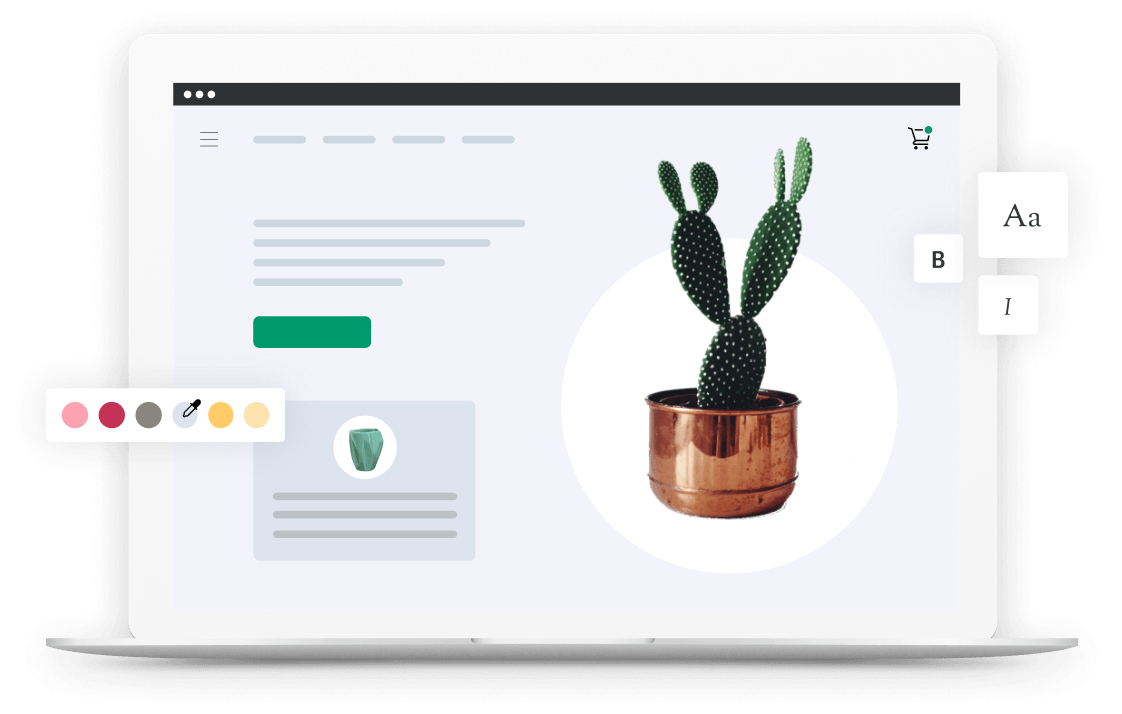Adobe Commerce (Magento) vs. WordPress vs. Shopify
Adobe Commerce (Magento) or WordPress or Shopify?
Shopify offers online merchants a wide range of apps, and a dedicated mobile app to manage your store on the go.
Try Shopify free for 3 days, no credit card required. By entering your email, you agree to receive marketing emails from Shopify.

Why choose Shopify over Adobe Commerce (Magento) and WordPress
| Key features | |||
|---|---|---|---|
| Free trial | Adobe Commerce (Magento) | WordPress | Shopify |
| 24/7 support | Adobe Commerce (Magento) | WordPress | Shopify |
| Sell online and in-store | Adobe Commerce (Magento) | WordPress | Shopify |
| Business capital | Adobe Commerce (Magento) | WordPress | Shopify |
| Custom domain | Adobe Commerce (Magento) | WordPress | Shopify |
| SEO features | Adobe Commerce (Magento) | WordPress | Shopify |
| Hosting | Adobe Commerce (Magento) | WordPress | Shopify |
| Sell worldwide | Adobe Commerce (Magento) | WordPress | Shopify |
| Multi-currency support | Adobe Commerce (Magento) | WordPress | Shopify |
| Mobile-friendly | Adobe Commerce (Magento) | WordPress | Shopify |
| Fraud protection | Adobe Commerce (Magento) | WordPress | Shopify |
| Integrated checkout | Adobe Commerce (Magento) | WordPress | Shopify |
| Integrated fulfillment network | Adobe Commerce (Magento) | WordPress | Shopify |
| Email marketing tools | Adobe Commerce (Magento) | WordPress | Shopify |
| App Store | Adobe Commerce (Magento) | WordPress | Shopify |
| Mobile app for merchants | Adobe Commerce (Magento) | WordPress | Shopify |
Start selling with Shopify today
Try Shopify for free, and explore all the tools and services you need to start, run, and grow your business.

7 things Shopify can do over Adobe Commerce (Magento) and WordPress
Make theme setup easier
Adobe Commerce (Magento) is a powerful platform capable of giving Shopify a run for its money, but it’s not nearly as easy to set up as Shopify is. While easy to set up and configure, WordPress can be challenging when it comes to installing or changing themes. Shopify, however, has been designed for non-technical users, which makes customization and setup a breeze.
Provide omnichannel marketing support
Shopify enables you to build a seamless omnichannel customer journey by integrating social media platforms such as Facebook, Instagram, Pinterest, and TikTok with other ecommerce platforms like Amazon, AliExpress, and Walmart to create an interconnected shopping ecosystem that has your store at the heart of it.
Offer blazing-fast performance
Plug-ins and third-party customizations are the bane of a fast online store, which is exactly what happens with WordPress and Adobe Commerce (Magento) stores. As soon your store gets complicated, adding plug-ins seems like a solution but only interferes with store performance. Shopify is a much leaner platform, which ensures you will always get top speed scores in the Google Lighthouse test.
Own a first-party POS
Adobe Commerce (Magento), like WordPress, integrates with every major third-party point-of-sale solution, but it doesn't offer a native point-of-sale solution to prevent software bloating. In addition to its fully integrated POS system, Shopify also provides options for tipping, local delivery, in-store pickup, and other retail-specific functionality.
Offer Shop Pay
Adobe Commerce (Magento), like Shopify, offers a native, customizable payment gateway. Since WordPress isn’t an ecommerce-first platform, you need to integrate with third-party software to receive payments, which results in hefty fees. Adobe Commerce (Magento), despite offering gateways with reduced fees, lacks many of the international payment options available for Shopify merchants, as well as Shop Pay, Shopify's accelerated checkout option.
Future-proof design
Adobe Commerce (Magento) and Shopify are great choices for modern ecommerce websites. Many WordPress users are switching and migrating their operations to platforms with more tools to support their future operations. During 2020 and 2021, Shopify has been able to regear and face the pandemic by quickly launching new features to support contactless delivery for merchants around the world. The platform even supports 3D models and augmented reality on product pages, which are becoming increasingly popular.
Create a commerce-first platform
Unlike WordPress, Shopify was built from scratch to be an ecommerce platform. Adobe Commerce (Magento) was created for the same purpose but lacks the customization options and user-friendliness Shopify brings to the table.
Why merchants choose Shopify over Adobe Commerce (Magento) vs. WordPress
Plenty of design options
People often avoid websites with clunky or confusing designs the same way they avoid a messy, chaotic high-street shop. A professional storefront can be created with Shopify’s tools. You can choose from a broad range of themes, from minimalist and understated to bold and vibrant.
Exclusive Shopify apps
You’ll find a variety of free Shopify apps in the Shopify App Store, including some that are exclusive to Shopify, like Oberlo for sourcing products and ShopCodes for creating QR codes.
Sell internationally
Regardless of where you live, Shopify’s cross-border tools can help you reach shoppers throughout the world. By offering localized shopping experiences, cross-border selling enables your company to reach shoppers worldwide. Creating awareness of your brand on a global scale is another benefit of selling internationally.
The best marketing tools
Shopify offers many tools, such as blogging CMS, sales channels, automatic discounts, gift cards, and Shopify Email, that make it easier for merchants to deliver an exceptional shopping experience to their customers.
24/7 international customer support
Shopify merchants love that they can chat with support via phone, chat, or email. This gives them the flexibility or immediacy of getting the help they need when they need it. Support is available 24/7 to answer any questions you have. If you want to get started on your online store journey but don’t have the tools, Shopify’s Contact page is the place to start. Find the answers you need from the Shopify Community or our award-winning support team.
Affordable dropshipping options
While Adobe Commerce (Magento) and WordPress enable merchants to dropship, on Adobe Commerce (Magento), users need to pay $249 to use the Dropship extension. Shopify, on the other hand, has several options for dropshipping and enables you to choose between many different free and paid options.
Secure platform for everybody
In addition to Shopify’s SSL certificate, which shoppers look for as a security indicator, the company offers fraud risk reduction through its built-in fraud prevention tool, which notes if an order is low, medium, or high risk.
We’ve been able to build something in 3 years that a lot of brands haven’t actually gotten to in 10 years.
Learn More About Shopify

Compare Shopify
See how Shopify compares to other platforms

Shopify Community
Learn from business owners on the Shopify forums

Shopify Help Center
Find answers to all your Shopify questions fast
Start selling with Shopify today
Try Shopify for free, and explore all the tools and services you need to start, run, and grow your business.
FAQs
Which is better for ecommerce: Adobe Commerce (Magento) vs. WordPress?
WordPress is a web CMS that doubles as a website builder. While many websites use WordPress, it simply can’t match an ecommerce-first platform. Adobe Commerce (Magento), despite its potential, tends to require technical help to be correctly set up, which makes it unwieldy for non-technical users. Shopify offers merchants the best of both worlds: a robust ecommerce platform that’s easy to use and set up and provides amazing results.
Which is cheaper: Adobe Commerce (Magento) vs. WordPress?
Both Adobe Commerce (Magento)—at least in its Community Edition—and WordPress are free. However, despite being apparently cheaper options, both come with a series of hidden costs, mainly development costs. While the platform is free and you can develop your store yourself, you’ll find soon enough how hard it can be. Shopify’s price starts at 17988/month when paying yearly, and offers a transparent pricing policy that ensures that you get what you’re paying for.
Which is better for SEO: Adobe Commerce (Magento) vs. WordPress?
WordPress relies on third-party plugins like Yoast to optimize content for search engines. On the other hand, Shopify offers native SEO capabilities to optimize every part of your website, from the content to the images. Shopify offers advanced SEO capabilities that go beyond meta tags to increase your chances of ranking your website.
Page last updated: January 24, 2022
What’s the best commerce platform for you?
Learn why thousands of businesses migrate to Shopify every year.